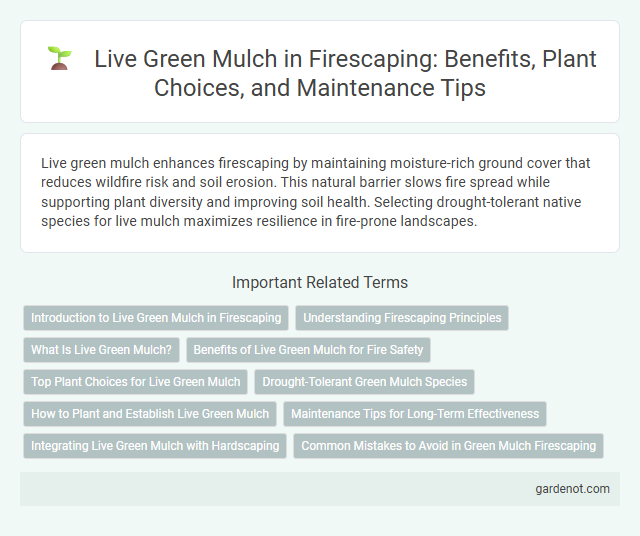Live green mulch enhances firescaping by maintaining moisture-rich ground cover that reduces wildfire risk and soil erosion. This natural barrier slows fire spread while supporting plant diversity and improving soil health. Selecting drought-tolerant native species for live mulch maximizes resilience in fire-prone landscapes.
Introduction to Live Green Mulch in Firescaping
Live green mulch in firescaping consists of low-growing, moisture-retentive vegetation strategically planted to reduce soil erosion and minimize wildfire spread by maintaining higher humidity levels near the ground. Species such as drought-tolerant grasses, succulents, and native ground covers provide effective fire resistance due to their high moisture content and low flammability. Incorporating live green mulch alongside fire-resistant landscaping enhances overall property protection by creating defensible space that slows fire progression and supports ecosystem health.
Understanding Firescaping Principles
Live green mulch serves as a vital component in firescaping by creating a moisture-rich barrier that reduces the likelihood of wildfire ignition around structures. Plants such as low-growing succulents, clover, and native grasses retain soil moisture and inhibit the spread of dry, flammable debris. Integrating live green mulch into landscape design supports fire-resistant zones by maintaining healthy vegetation that resists combustion while enhancing soil stability and reducing erosion.
What Is Live Green Mulch?
Live green mulch refers to the use of living plants, such as low-growing ground covers or perennial grasses, to protect soil and suppress weeds while providing a natural barrier against fire. This sustainable planting technique enhances soil moisture retention and reduces combustible material around homes, making it an effective component of firescaping strategies. Common species used as live green mulch include creeping thyme, sedum, and certain ornamental grasses known for their fire-resistant properties.
Benefits of Live Green Mulch for Fire Safety
Live green mulch significantly reduces fire risk by maintaining higher moisture levels in the soil and surrounding vegetation, which slows fire spread. Its dense, living ground cover acts as a natural barrier against flames and embers, minimizing combustible dry material near structures. Integrating drought-tolerant, fire-resistant plants in live green mulch enhances landscape resilience and promotes a safer defensible space.
Top Plant Choices for Live Green Mulch
Top plant choices for live green mulch in firescaping include drought-tolerant species such as creeping thyme, native sedums, and low-growing clover varieties that maintain moisture while reducing flammable material. These plants create a fire-resistant ground cover by retaining soil moisture and slowing fire spread with their high water content and minimal dead foliage. Selecting native, fire-adapted plants enhances landscape resilience and promotes ecological balance in fire-prone areas.
Drought-Tolerant Green Mulch Species
Drought-tolerant green mulch species such as sedum, creeping thyme, and blue grama grass effectively conserve soil moisture while reducing fire risk in firescaping designs. These live mulches form dense, low-growing mats that minimize exposed soil and inhibit weed growth without the need for frequent irrigation. Utilizing native drought-resistant plants tailored to local climate zones enhances landscape resilience and promotes sustainable water use.
How to Plant and Establish Live Green Mulch
To plant and establish live green mulch, select fire-resistant ground cover species such as creeping thyme, sedum, or native grasses that thrive in your local climate. Prepare the soil by loosening and amending it with organic matter to enhance moisture retention and root development before planting. Space plants evenly to allow full coverage and water regularly until the mulch is well-established, ensuring a dense, fire-retardant living barrier.
Maintenance Tips for Long-Term Effectiveness
Live green mulch requires regular watering to maintain soil moisture and prevent drought stress, especially during dry seasons. Pruning and trimming the mulch plants encourage healthy growth and inhibit invasive species from taking over, ensuring optimal fire-resistant barriers. Fertilizing with organic compost every few months replenishes nutrients, promoting robust plant health and enhancing long-term fire protection efficiency.
Integrating Live Green Mulch with Hardscaping
Integrating live green mulch with hardscaping enhances fire-resistant landscaping by creating natural barriers that reduce combustible material near structures. Selecting drought-tolerant, low-growing plants like sedum or creeping thyme complements stone pathways and patios while maintaining moisture and limiting fire spread. Combining permeable hardscape elements with dense, fire-retardant green mulch improves both aesthetic appeal and defensibility against wildfires.
Common Mistakes to Avoid in Green Mulch Firescaping
Using live green mulch in firescaping demands careful selection of drought-resistant, fire-resistant plants like sedum or creeping thyme to minimize fire risk. Avoid planting species with high resin or oil content, such as juniper or eucalyptus, as they increase flammability and can intensify wildfire spread. Proper spacing and regular maintenance, including pruning and debris removal, are critical to prevent dense vegetation buildup that fuels fires.
Live green mulch Infographic

 gardenot.com
gardenot.com